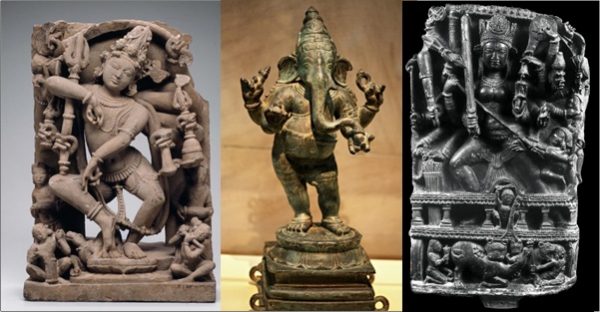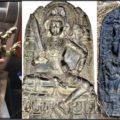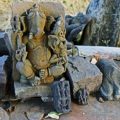The Plunder of Our Temples and Heritage: Why Indians Don’t Care

Let’s take a moment and go back to 11 September 2001. After the 9/11 attacks, the USA decided to hit back with all its might. A provocation that lasted a few hours, has been followed up by decades of a “response”. The “war on terror” has already cost the US $2 trillion and will cost $6 trillion over the coming generation. To put that in perspective, that’s about $64,000 per American family — way much more than the average American family income for a whole year.
It makes one wonder if the response was disproportionate to what America saw as the upside. Now, that begets the real question – what really is the upside? Different theorists have offered differing explanations as to why Americans decided to hit back so hard. Explanations ranging from “control over oil reserves”, to “political exigency”, to “Hey, the US really hasn’t won a war since World War 2. They just need to showcase a win.”
While the “control over oil” explanation seems the most logical, it is intriguing that the US has excluded the real oil rich nations in that region (Saudi Arabia, UAE, Iran, Kuwait and Qatar) from such aggression. Backchannel diplomacy, trade agreements and lobbying are significantly more efficient ways to keep the oil flowing.
The most plausible explanation is quite simply, the “hitting back” theory. With banks and financial institutions and regulators housed in there, the World Trade Centre represented at its very core, the core of America — capitalism. That is precisely what the perpetrators wanted to attack.
Symbolic Destruction
Destruction of symbols is a huge part of any conflict. Not to belittle the issue, but my kids make sure they lick the last cookie on the plate. Dogs mark their territory by urinating around it. Bears scar trees in their area.
Humans, with their superior intelligence and dexterity, destroy symbols of a higher order. Therefore, in battle, the first thing you did was bring down the enemy’s symbol — their flag.
Jewish art was systematically looted by the Nazis. The Bamiyan Buddhas were destroyed by Taliban. More recently, ISIS razed Palmyra to the ground — all of this to destroy symbols and establish cultural conquest.
So when the terrorists decided to bring something down, they picked the Twin Towers; simply because it represented everything they despised about America. Because capitalism and progress were core to America’s identity; the terrorists decided, that core is precisely what had to be brought down.
The US, on the other hand, refused to look at the “war on terror” in return-on-investment terms. Their core was under attack, and they had to protect it. No matter the cost.
India’s core identity
Now contrast this with India’s core identity and how we respond when it is attacked.
While all our scientific and IT prowess has steered our image away from “the land of milk and honey”, India is still known and visited for its amazing heritage. No mention of India is complete without discussing the Taj Mahal or the amazing forts of Rajasthan or the mesmerising temples of Tamil Nadu. In short, heritage is India’s core identity.
That core identity, our heritage, has been attacked for centuries. The Mughals plundered our forts and temples, then the colonials did. This didn’t end with Independence. It is estimated that, since 1947, India has lost thousands of idols, maps, manuscripts, etc to the illicit heritage trade.
And how does India react? Well, we choose to showcase our “tolerant side” and “strategic restraint”. Since India’s independence, we have not brought even one significant heritage-criminal to justice. On many an occasion, in different parts of the world, I have been asked a variant of the same question — “If India cannot protect its most amazing assets, then what are you so proud of?”
India continues to languish with the out-of-date Antiquities Act, and even if we were to update that, it would be a toothless piece of paper, with no enforcement-wing to enforce such a law.
So in the end, when people attack our core, they know they will get away with it.
When USA and Pakistan share the podium…
Let’s go back to the US for a moment. Clearly, heritage isn’t core to them, in a way it is to India. Let’s see how they respond to the issue.
Democrat Bill Keating recently tabled a Bill in the US Congress — ‘HR 2285: Prevent Trafficking in Cultural Property Act’. The strong Trump-Hillary friction is no secret and an overall mood of adversity (among political parties) prevails. GovTrack USA applied an algorithm and predicted a 34% chance of this Bill passing.
However, something amazing happened on 22 September 2016. This Bill was passed 415-0. Yes, you heard that right. Democrats and Republicans got together, across the aisle, to publicly recognise the issue, and decided that both parties need to come together to deal with it. To back their intent with action, they have always had the fairly efficient Cultural Property Division under the Department of Homeland Security, to enforce these laws.
Having said this, one is aware of the naysayers that will argue that heritage protection is a “first world luxury”, and India will get to it when we are done with feeding our poor. Here sir, is a contrasting example, specially for you naysayers.
Let’s look towards our “friendly” next-door neighbour, Pakistan.
The KP Antiquities Act, 2016 increases financial penalty on heritage crimes by 40 times (compared to last year). The law also establishes the Antiquities Trade Control Wing to regulate and monitor the illegal trafficking of antiquities.
So there you have it — a study in contrasts. Both the USA and Pakistan have (a) a newly updated law to deal with heritage-crimes, and (b) enforcement wings to restrain heritage-criminals.
India has neither.
Personally for me, as a deeply patriotic Indian, it’s a sad day when India needs to follow Pakistan’s lead!!!
In March 2015, the University of Chicago organised a conference in New Delhi titled, “The Past for Sale: Protecting India’s Cultural Heritage”. Scholars, archaeologists, historians and activists from across the world discussed India’s heritage “being sold on the international market without legal authorisation”. In short, Indian heritage being looted and smuggled abroad.
While global experts got together to discuss this deep-rooted plunder of India’s heritage, there was one group of people conspicuous by their absence, the Indian Ministry of Culture, or for that matter, any of its agencies (the Archaeological Survey of India, National Museum, etc).
On the one hand, it may seem bizarre that global experts convened in Delhi, but our officials couldn’t find the time to join them. On the other hand, in a resource-constrained country like India, one could argue that heritage theft is not a serious enough challenge. One could hypothesise that the government has other “more important” priorities.
A HYPOTHESIS WORTH TESTING
UNESCO estimates that 50,000 idols and artefacts had been stolen out of India till 1989. Advocacy group Global Financial Integrity estimates that the illegal trade of arts and artefacts is worth Rs 40,000 crore a year. As an example, a single sandstone sculpture stolen from Madhya Pradesh was worth Rs 100 crore in the international market.
These are not isolated incidents though. India has lost thousands of heritage objects to the international heritage-mafia. Idols, maps, manuscripts, paintings, murals, etc., are looted en-masse and find their way to New York, London, Zurich and other “playgrounds for the rich”.
India has the dubious distinction of being one of the biggest victims to this trade—a self-denigrating victim, which has, for long, allowed perpetrators to loot our heritage. However, awareness of this rare, even disgraceful, honour is missing in most Indians’ minds. In one word, there’s the problem—apathy.
IT’S NOT JUST ABOUT THE MONEY, HONEY
In February 2015, the United Nations Security Council (UNSC) expressed its concern that the Islamic State (ISIS) “are generating income from engaging directly or indirectly in the looting and smuggling in cultural heritage items (…) to support their recruitment efforts and strengthen their operational capability to organize and carry out terrorist attacks”.
As a response, the UNSC adopted its Resolution 2199, formally recognising art and antiquities trafficking as a terrorist financing tool.
In August 2015, the Federal Bureau of Investigation (FBI) issued an advisory stating, “Purchasing an object looted and/or sold by the Islamic State may provide financial support to a terrorist organization and could be prosecuted under 18 USC 233A.”
German Commissioner for Culture (Deputy Minister) Monika Grütters, made a public statement earlier this year, stating she is working towards curbing such financing by pushing for stricter regulations on artefacts entering Germany. She made it a point to emphasise to the international community, “We must act against this trade.”
Interpol has a dedicated Art-Crimes Wing based in Lyon, France. They have an enviable database of about 50,000 stolen heritage objects. Enforcement authorities across the world use this database on a regular basis to track and recover stolen heritage.
India unfortunately, neither contributes to this database, nor leverages it to track heritage crimes.
BOMBS FOR GANESHAS
While most of these responses and sanctions were directed towards curbing terror-funding, we must not forget that the heritage-mafia is a globally networked ecosystem. It really does not matter if an artefact was looted from Cambodia, Egypt or India. Most of these looted-objects share the same shipping-agents, trade-routes, hawala agents, auction-houses and art-dealers.
It is an intricate network of regenerative tentacles, where one tentacle feeds the other. When you cut one off, another grows in its place.
The only way out is to have an impenetrable defence mechanism. The only way is to enforce, with an iron hand, when any such perpetrators are caught.
If we don’t, then as the United Nations says, we should be ready for our heritage to be sold, for bombs to be bought.
Legend has it that Mahishasura, the most powerful in the Asura kingdom, derived his powers from Lord Brahma’s boon. Mahishasura had asked for immortality, but Brahma watered it down to a boon where Mahishasura “could not be destroyed by man, god, demon or beast”. Mahishasura, in all his arrogance, ignored that “woman” was not part of this list.
Armed with this boon, Mahishasura started a campaign to conquer the three worlds and went about destroying the gods (devas). The citizens of devaloka resisted, but were driven out of heaven. They rushed to the higher gods for help.
Brahma, Vishnu, Shiva and the citizens of devaloka pooled their powers together, and from it was born Durga. Each of her arms held a weapon gifted by the gods. Brahma’s kamandala, Vishnu’s chakra and Shiva’s trishul. A long battle ensued in which Durga finally vanquished Mahishasura, and restored order in the three worlds, thereby earning her the moniker Mahishasura Mardini.
In short, what could not be achieved either by citizens (of devaloka), or the gods alone, was achieved when they all got together against the common enemy.
Now, let’s draw a parallel with our modern-day asuras in the heritage mafia. Let’s call them “Paramparasuras”, the destroyers of parampara (heritage).
Paramparasuras are the almost invincible asuras that loot and destroy temples and forts across India. Like Mahishasura, they have derived their powers from a “boon” of perceived invincibility—a lack of consequence or punishment, notwithstanding how much they plunder.
Armed with this “boon”, the Paramparasuras have run a very lucrative enterprise of destruction, exporting stolen Indian heritage across the world, where it is sold for millions. This destruction by the Paramparasuras has run unabated for the past 70 years, even if we were to ignore the pre-Independence era. Government agencies, the police, citizens’ volunteer-groups and others have carried on independent efforts, but have failed rather miserably.
It really is an existential crisis for Indian heritage.
The question is this: Do we, as a nation, let Paramparasuras prosper, or do we destroy them once and for all? If we do choose to destroy them, then what can we, as a nation, do to permanently terminate the destruction and peddling of our heritage?
The answer simply is to form alliances like Brahma, Vishnu and Shiva did with citizens of devloka, to bring down Mahishasura.
I suggest a five-point collaborative-framework to stem these Paramparasuras:
1. Heritage Squad
Let’s take an example of cyber-crimes. We don’t expect an average policeman to solve cases of computer-hacking, phishing or identity theft. Why? Because these are sophisticated crimes that need sophisticated skills. Similarly, heritage-crimes involve international players, multiple currencies, complex shipping routes and reams of documentary evidence. Unless we have a separate enforcement wing with specific expertise in this area, we are unlikely to ever solve heritage-crimes.
2. Updated Legal Frameworks
Indian heritage and antiquities are protected by a law, that is considered out-of-date by the Minster-of-Culture himself. While there is widespread debate on the components of the updated bill to be placed in Parliament, there is no debate on whether we need a new one. I sincerely hope we learn from the rest of the world and incorporate best practices that have worked in various countries. Like I said in the second part of this series. If Pakistan can do it, so can we.
3. National Heritage Archive & Database
Not to be dramatic about it, but a ration-shop owner today knows what stock and assets he has in his ration-shop. It is paradoxical then, that we as a nation have no comprehensive public record of our heritage assets. Not only will such a database help in building a disincentive for the heritage-mafia (knowing that they can’t dispose of a stolen artefact, as its record exists somewhere), but will be a matter of great pride for heritage-enthusiasts and citizens to refer to.
4. Diplomatic efforts & International Partnerships
India is not alone in this battle. Since the UNESCO Convention on Cultural Property 1970, numerous nations have built structures and shown a very serious intent of curbing heritage-crimes. In the past two years alone, five different countries have returned Indian heritage back to us. Of course, with effort from the Ministry of External Affairs. However, such restitutions cannot be ad-hoc affairs, neither should they stay limited to a handful of numbers, as it is now. India needs institutions and structures that build bridges with their international counterparts, and turn “ad-hoc restitutions” into a process. The world has taken a step towards India. It is time we reciprocated.
5. Public Private Partnerships (PPP)
It is heartening to see the current government’s focus on bringing in private-enthusiasm to solve public-issues through PPP models. However, why limit PPP models to developmental and financial projects? Why not build PPP models in the social and cultural space as well? This is an emotional subject that is close to people’s hearts. This is also a subject where many privately run groups, India Pride Project being one, have shown (a) demonstrated success, and (b) established international relationships. If we invite private experts to run our ports, highways, schools and hospitals, then why not bring in private experts to save our heritage?
Having made these points, the biggest risk is this: half-measures and half-solutions. Bureaucratic half-heartedness very often ensures that boxes are ticked, without it ever bringing the change it was meant to. As Prof R. Vaidyanathan humorously puts it, “Operation is successful, but patient is dead.”
It will come as a surprise to nobody, if one or two of these measures are adopted and the rest ignored. Soon thereafter, the effort dies a natural death, simply because it wasn’t structured comprehensive and robust enough to begin with.
The real question is this: can we as Indians, sit by and let our heritage keep getting destroyed (emphasis on the present continuous tense), especially when we knew that it is so easy to solve, when we know we can all be Paramparasura Mardinis?
If a Mahishasura could be destroyed when citizens and their rulers got together, what chances do mere mortal Paramparasuras have?
This article (published as a series of 3 articles) was first published at Sunday Guardian Live.






